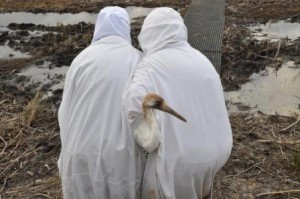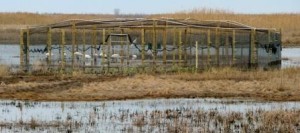
Costumed caretakers process a bird at the release pen in Louisiana. Photo by Brac Salyers, LDWF
There are many success stories on species recovery associated with the Louisiana Department of Wildlife and Fisheries (LDWF) and in February 2011 LDWF added one more. The department’s Coastal and Nongame Resources Division (CNR) moved forward with a whooping crane re-population project that will be as challenging as any previous effort.
“LDWF biologists have a proven track record for bringing back species from threatened or endangered status to robust population levels readily noticeable around the state,” said LDWF Secretary Robert Barham. “From the alligator and the brown pelican, to the bald eagle and the white-tailed deer, our citizens can see the results of years of tedious field work. The expertise and dedication that LDWF biologists bring to a long-term restoration plan is truly impressive.” For Louisianans, the sight of a whooping crane in the wild has been only a distant memory. The last record of the species in Louisiana dates back to 1950, when the last surviving whooping crane was removed from Vermilion Parish property that is now part of LDWF’s White Lake Wetlands Conservation Area (WLWCA).
The whooping crane is the most endangered crane species. Fifteen species of cranes occur throughout the world; only two of the 15 species, sandhill cranes (Grus canadensis) and whooping cranes (Grus americana) occur in North America. Today, sandhill cranes are prevalent, but whooping cranes are in great peril, having suffered severe population declines during the late 1800s and most of the 1900s. Due to these declines, whooping cranes were placed on the federal endangered species status list on March 11, 1967. The population slowly increased over the last 30 years with approximately 565 individual whoopers in North America as of Jan. 31, 2011.
Historically, both resident and migratory populations of whooping cranes were present in Louisiana through the early 1940s. The massive birds, with males growing to 5 feet tall at maturity, inhabited the marshes and ridges of the state’s southwest Chenier Coastal Plain, as well as the uplands of prairie terrace habitat to the north. According to Dr. Gay Gomez, professor of geography at McNeese State University and Louisiana whooping crane historian, “Records from the 1890s indicated ‘large numbers’ of both whooping cranes and sandhill cranes on wet prairies year round.”
The Louisiana whoopers are not the only cranes in the wild. A self-sustaining wild population of whooping cranes migrates between Wood Buffalo National Park in the Northwest Territories of Canada and Aransas National Wildlife Refuge in Texas. Like those in an eastern migratory population, the Aransas group remains vulnerable to extinction from continued loss of habitat and catastrophes, either natural or man-made. Multiple efforts are underway to reduce these risks and bring this magnificent bird further along its path to recovery. This includes increasing populations in the wild, ongoing efforts to establish a migratory population in the eastern United States and establishing a resident (non-migratory) population in Louisiana. The White Lake marshes and vast surrounding coastal marshes of southwest Louisiana was a positive factor in the decision making process that led to the experimental population approval.
The Louisiana crane population did not withstand the pressure of human encroachment, conversion of nesting habitat to agricultural acreage, hunting, and specimen collection, which also occurred across North America. Dr. Gomez’s research indicates “In May of 1939, biologist John Lynch reported 13 whooping cranes north of White Lake and that in August 1940, flood waters associated with a hurricane scattered the resident White Lake population of cranes and only six of the 13 cranes returned. By 1947, only one crane remained at White lake and in March of 1950, the last crane in Louisiana was captured and relocated to Aransas National Wildlife Refuge, Texas.”
Whooping cranes currently exist in three wild populations and within captive breeding populations. Captive breeding facilities are responsible for providing eggs that will eventually be released back into the wild. The 10 juvenile cranes relocated to White Lake on February 16 were raised at the Patuxent Wildlife Research Center in Laurel, Md. The eggs were hatched in May and June 2010 by birds in four locations including the Calgary Zoo in Alberta, Canada, Necedah National Wildlife Refuge in Necedah, WI. Audubon Species Survival Center in New Orleans and Patuxent facility. The young cranes were then flown to Jennings, La. and transported to the White Lake property.
The process preceding the cranes arrival, which involved project approval by the US Fish and Wildlife Service (USFWS), public meetings and a public comment period, spanned more than two years. “Without our cooperative partners, which includes USFWS, U.S. Geological Survey (USGS) and International Crane Foundation (ICF), this project would not have come to fruition,” said LDWF-CNR Division Administrator Robert Love. “We will continue to work closely with this group for years to come.”

Acclimation pen. Photo by Michael Seymour, LDWF
Upon their arrival in February, the birds were placed in a small, netted acclimation pen within a larger 1.5-acre pen located at WLWCA. The birds remained in the netted acclimation pen for approximately one month to allow proper transition to their new locale and to allow researchers and biologists the opportunity to ensure all birds were healthy and well acclimated to their surroundings. The birds adjusted quickly and within 24 hours of their arrival, one individual was observed catching and eating a wild crawfish. In addition to wild caught food, the birds have been receiving supplemental pelletized food referred to as crane chow. While contained within the acclimation pen, each bird was fitted with unique leg band colors, a USFWS I.D. band and satellite transmitter. The bands and transmitters will allow biologists and researchers the opportunity to study and follow each bird through its lifespan.
The White Lake cranes were released from the netted acclimation pen on March 14. Biologists conduct daily monitoring activities and continued supplemental feeding activities. The birds can roam free within the larger pen and actively fly in and out of the pen at their own discretion, roosting at night as they continue to acclimate to the marshes. “Providing access to food sources in the pen early on was designed to attract the group back to the safety of the predator-proof enclosure at night,” said Tom Hess, LDWF-CNR biologist program manager. “Our concerns early on were for the birds to develop predator avoidance skills in a marsh environment also inhabited by alligators, bobcats and coyotes.”
The goal of the state’s reintroduction project is to establish a self-sustaining whooping crane population on and around White Lake, which contains over 70,000 acres of freshwater marsh. A self-sustaining population is defined as a flock of 130 individuals with 30 nesting pairs, surviving for a 10-year period without any additional restocking. Whooping cranes do not generally nest until 3-5 years of age, so the nesting success of the Louisiana group may take several years to be determined. The long-term goal of this reintroduction is to move whooping cranes from an endangered species status to threatened status. Future plans for the project include re-introductions of additional juvenile cohorts once or twice a year for the next two years. At that point, the project will be evaluated to determine the number of birds for released in future years.
The newly established whooping crane population at White Lake is designated as a nonessential experimental population (NEP) under the provisions contained within section 10(j) of the Endangered Species Act. The population is considered experimental because it is being reintroduced into suitable habitat that is outside of the whooping crane’s current range, but within its historic range. It is designated nonessential because the likelihood of survival of the whooping crane as a species would not be reduced if this entire population were not successful and lost. The NEP status will protect this whooping crane population as appropriate to conserve the population, while still allowing the presence of the cranes to be compatible with routine human activities in the reintroduction area. Examples of such activities include recreational hunting and trapping, agricultural practices (plowing, planting, application of pesticides, etc.), construction or water management.
Although designated as NEP, the Louisiana whooping cranes are still protected under law. Because of the experimental non-essential designation in this rule, if the shooting of a whooping crane is determined to be accidental and occurred incidentally to an otherwise lawful activity that was being carried out in full compliance with all applicable laws and regulations, no prosecution under the Endangered Species Act would occur. In the case of an intentional shooting, however, the full force and protection of the Endangered Species Act could apply. Additionally, the birds are protected under applicable state laws for non-game species and the federal Migratory Bird Treaty Act, which protects all birds that migrate such as herons, egrets and songbirds.
“We want anyone in the marsh near White Lake to enjoy the moment should they encounter one or more of the experimental birds in the wild during this re-population effort,” said Love. “As long as the cranes are observed at a distance, they should adapt to occasional human encounters.”
Project funding for Louisiana’s whooping crane project is derived from LDWF species restoration dedicated funds, federal grants and private/corporate donations. LDWF’s budget for the initial year of the project is $400,000. The project costs escalate in year two and beyond as the project expands. LDWF estimates it will be necessary to raise three to four million private dollars to help fund a portion of this 15-year project.
Private and corporate donations supporting the whooping crane project can be made to the Louisiana Wildlife and Fisheries Foundation. Gifts should be designated as “support of the Whooping Crane Project.” For information on the foundation and to obtain a donation form go to http://www.wlf.louisiana.gov/lwff. For more information on the historic re-introduction of whooping cranes to Louisiana, visit http://www.wlf.louisiana.gov/wildlife/whooping-cranes.
Carrie Salyers, Louisiana Department of Wildlife and Fisheries

